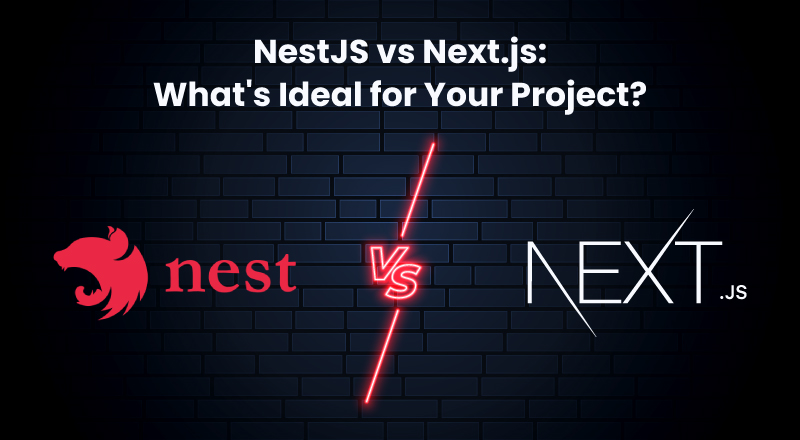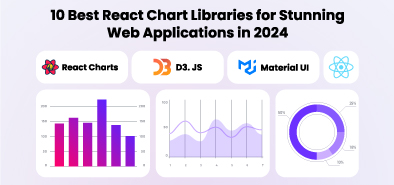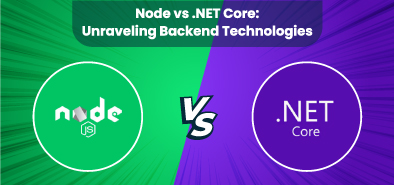Nest.js vs Next.js: What’s Ideal for Your Project?

The web development framework is employed as support and provides an efficient way to develop an application. It evolves with various functionalities and features, making the development process easier, and developers consistently find faster ways to code.
A few of the frameworks often come with extraordinary features, which reduce code and make application development faster and more efficient. Hence, the increasing demand for frameworks has led to the development of numerous frameworks, providing multiple options to choose from. Therefore, it’s a challenging task to stay up-to-date with the latest web development technologies and decide which ones to use.
Today, let’s dive into the Nest.js vs. Next.js comparison, focusing on their key features, architecture, performance, popularity, and use cases. Both have experienced growth in a shorter period and continuously gather the user’s attention.
What is Nest.js?
Nest.js is an open-source, progressive Node.js framework created by Kamil Mysliwiec to facilitate the development of scalable server-side applications. It is widely used to build backend services and for server-side application development, making it ideal for creating structured and maintainable APIs and backend systems. Nest.js offers cross-platform functionality and combines the concepts of OOPS (Object-Oriented Programming) and FP (Functional Programming).
Next.js was developed to address the architectural issues encountered in Node.js by providing a modular structure to organize code. Moreover, it is written in TypeScript, which enables type checking.
Interesting Reads: Top 11 NodeJS Libraries Every NodeJS Developer Must Know
A Few Essential Reasons to Choose Nest.js:
Extensibility Using Modularity Structure:
It provides extensive flexibility to developers to use any other libraries as needed and to maintain the applications.
Full-Stack Development:
It is helpful for full-stack development because it can be used in conjunction with any front-end framework, allowing for seamless integration between the front-end and back-end.
Extensive Support for Modules:
It supports various modules and provides integration with many technologies (e.g., mongoose, WebSocket, etc.).
What is Next.js?
Next.js is a React front-end development web framework created by Vercel (formerly Zeit) in 2016, which assists with functionalities such as server-side rendering and static site generation. It is a powerful framework for building user interfaces with React, enabling the creation of dynamic and high-performance web applications.
It is designed for building full-stack web applications. Using React Components for UI increases the features and optimizations. Next.js provides built-in features allowing developers to efficiently implement functionalities like TypeScript support and dynamic routing. A key feature is its file-based routing system, which simplifies navigation and route management by automatically mapping the file structure to website routes. It offers advanced features such as automatic code splitting, TypeScript support, server-side rendering, and more. Additionally, it qualifies the sharp and efficient coding for high-performance apps.
Being built on React, it holds most of its features, and additionally, it does not require any webpack configurations. That is the only reason the developers have found it more efficient compared to others.
Performance and Scalability of NextJS
When evaluating performance and scalability, both Next.js and Nest.js stand out as robust choices for building modern web applications, but they excel in different areas of the stack.
Next.js is engineered to optimize frontend performance through advanced features like server side rendering (SSR), static site generation (SSG), and automatic code splitting. These capabilities enable developers to deliver efficient web applications with lightning-fast page loads and smooth user experiences. With static site generation SSG, Next.js pre-builds pages at compile time, making it ideal for static websites and content-driven platforms. Its server side rendering capabilities ensure that pages are rendered on the server, improving SEO and initial load times. Additionally, features like incremental static regeneration allow for seamless updates to static content without a full rebuild, supporting scalability as your site grows.
On the backend, Nest.js is purpose-built for scalable server side applications. Its modular architecture and modular structure allow developers to break down complex applications into manageable, reusable modules, which is essential for large scale enterprise applications. Nest.js leverages dependency injection techniques to manage complex dependencies, enhancing code quality and maintainability. The framework’s built-in support for API routes and backend APIs streamlines the process of building robust server side applications. Furthermore, Nest.js is well-suited for distributed systems and microservices, enabling developers to scale backend performance efficiently as demand increases.
In summary, Next.js and Nest.js both enable developers to build high-performance, scalable web applications. Next.js shines on the frontend with static site generation, server side rendering SSR, and automatic code splitting, while Nest.js excels on the backend with its modular architecture, dependency injection, and support for distributed systems. Together, they provide a powerful foundation for efficient, scalable, and maintainable web applications.
Essential Reasons to Choose Next.js:
1. Server-Side Rendering (SSR)
SSR means the web pages are generated and rendered on the server side, which means the client browser will receive a fully formatted HTML document, which helps us to make the web page faster and efficient.
2. Router Configurations
It provides a specific router that needs to be installed while working with Next.js. Additionally, it configures itself and requires no additional configuration.
In Next.js, the routing system can be set up using the pages directory, where each file inside the /pages directory automatically becomes a route in your application.
3. Ability to Pre-render Web Page at Build Time:
It is also known as SSG (Static Site Generation), a built-in feature in Next.js that employs a web development technique where web pages are pre-rendered at build time, rather than being dynamically rendered on the server or client side. This process generates static pages, which are pre-built and can be served directly from a CDN for faster load times and improved performance.
Interesting Reads: Top 20 Front End Frameworks For Faster And Efficient Development
Advantages & Disadvantages of Nest.js:
Advantages of Nest.js
- TypeScript Support: It provides a built-in TypeScript feature, which is a superset of JavaScript. This helps catch errors early, improving code quality and accuracy.
- Modular Architecture Support: This feature allows developers to classify their code into reusable and decoupled modules. This makes it easier to manage complex applications and encourages code reuse.
- Build-in DI Support: It has built-in support for dependency injection which helps to make it easier to write modular and sustainable code.
- Scalability: It is designed to be highly scalable. It leverages the event-driven architecture and the reactive programming model to handle a huge number of concurrent requests capably.
- Prompt Compatibility: It is built on top of the Express.js framework, utilizing its robust features while adding its additional abstractions and functionality. This ensures compatibility with the vast Express middleware ecosystem, allowing easy integration of existing Express middleware and libraries.
- Great Community Support: It has excellent documentation that provides comprehensive explanations, tutorials, and examples.
Disadvantages of Nest.js
- Standardized Code: Although it offers a robust foundation and architectural guidance, developers may find themselves writing more code when compared to using minimalist frameworks. The emphasis on modularity and the separation of concerns, while beneficial for maintaining a well-organized codebase, can occasionally result in additional boilerplate code, potentially extending development time.
- Performance Overhead: While it is generally efficient and performs well, the additional abstractions and layers it introduces, in contrast to minimal frameworks like Express, may lead to a slight performance overhead. Nevertheless, for the majority of applications, the impact on performance is minimal and is outweighed by the productivity benefits.
- Limited Ecosystem: Despite its compatibility with Express middleware, Nest.js has a comparatively smaller ecosystem compared to frameworks such as Express or Koa. Consequently, locating specific plugins or libraries tailored for Nest.js might be more challenging, although the community is continually expanding.
Advantages & Disadvantages of Next.js
Advantages of Next.js
- User Experience: It provides a marvelous and interactive user experience and offers you the freedom to create a user interface (UI) according to your needs.
- Rapid Development: It contains many ready-to-use components as well as libraries, which are useful for faster and more rapid development.
- Automatically Reduce Page Load Time: it is internally managing the necessary loading of JS and CSS which helps us to reduce the page load time and improves the user experience.
- SEO-Friendly: as we all know SEO is helpful to our application’s ranking by indexing the site in the top SERPs. It improves SEO by providing server-side rendering by default. Additionally, it provides the ability to add meta-tags dynamically inside the head components.
- Community Support: It has large community support. If you face any issues, it is easy to get the solutions quickly.
Disadvantages of Next.js
- Very low number of Plugins: compared to other technologies, it does not provide the expected number of plugins.
- Increase Your Cost for Front-end Development: It doesn’t provide as many as in-built front-end pages and it requires you to develop the front-end from scratch and update it promptly which increases your cost to hire a new resource for front-end development.
Next.js vs Nest.js: Key Differences
| Parameters |
Next.js |
Nest.js |
| Architecture and Structure |
Next.js follows a simple file structure, where pages are created as components with a filename matching the page URL. |
Nest.js follows a modular architecture based on modules and controllers. |
| Server-Side Rendering (SSR) |
Next.js provides built-in support for server-side rendering, which enables developers to render pages on the server before sending them to the client. |
Nest.js does not provide built-in support for server-side rendering. However, you can use it in combination with other libraries, such as React, to enable server-side rendering. |
| API Development |
Next.js is primarily focused on client-side development, but it does provide support for API routes, allowing you to create api endpoints directly within the application. |
Nest.js, on the other hand, is primarily focused on server-side development and provides built-in support for creating RESTful APIs. |
| Scalability |
Next.js provides a built-in feature to create a static site, which allows us to generate pages at build time, which enables faster page load times and improved performance. |
Nest.js provides a modular architecture that allows developers to scale their applications by breaking them down into smaller, reusable components. |
| Performance |
Next.js provides a built-in feature that supports server-side rendering, which outcomes in faster page load times and improved SEO. |
Nest.js provides a highly optimized runtime functionality that ensures the fast and efficient execution of code. |
| Community Support and Popularity |
Next.js has gained remarkable popularity in the recent few years, with many large companies using it to build their web applications. |
Nest.js is also gaining popularity and has become a go-to choice for many developers especially when they want to build server-side applications. |
| Learning Curve |
Next.js is relatively easier to learn, as it provides a simpler file structure and fewer abstractions. |
On the other hand, Nest.js requires a huge understanding of TypeScript and more complex concepts such as dependency injection. |
| Testing |
Next.js provides a set of tools and utilities which is helpful to simplify the testing process and make it easier to write in terms of testing. |
Nest.js provides a robust testing framework that allows us to write unit tests and integration tests for their applications. |
| Deployment |
Next.js can be deployed to various hosting platforms, including Vercel, Netlify, and AWS. Deployment is relatively straightforward, as Next.js applications can be deployed as serverless functions or static files. |
Nest.js applications can be deployed to any hosting platform that supports Node.js, making it highly flexible and adaptable to different deployment environments. |
| Framework Flexibility |
Next.js is primarily focused on client-side development and provides a set of tools and features which is helpful to simplify the development process. However, it is less flexible than Nest.js, as it provides fewer abstractions and less modularity. |
Nest.js, on the other hand, is highly flexible and provides a modular architecture that allows developers to create complex applications with ease. |
| Documentation |
Next.js provides a set of guidelines and tutorials that cover all aspects of the framework, from installation to deployment. |
Nest.js provides a detailed documentation site which is covering all aspects of the framework, including core concepts, modules, and utilities. |
Nest.js vs Next.js: The Similarities
#1 Framework Environment and Community Backing
When choosing a development tool, it is crucial to consider the supporting community and environmental considerations.
Next.js leverages its association with well-established frameworks and development tools in the React ecosystem, providing a distinct advantage. The framework is further boosted by outstanding documentation and an active community that is supporting its development.
Built on TypeScript with a significant influence from Angular, Nest.js taps into the robust development communities of both ecosystems. It not only provides a comprehensive array of components, libraries, and tools for streamlined development tasks but also encourages the adoption of standard procedures.
#2 Efficiency and Scalability in Operation
While designed for distinct use cases, both excel in delivering exceptional speed and versatility.
Next.js, with its server-side rendering capabilities and automatic code splitting, is particularly adept at enhancing front-end efficiency. Tailored for static websites and content-centric applications, it ensures swift loading times and improved SEO performance.
Nest.js places a greater emphasis on server-side and backend speed. It truly puts a shine on when it comes to developing APIs and microservices that demand high performance and the ability to handle substantial traffic volumes.
#3 Mastery and User Interaction in Development
Any framework’s learning curve and the proficiency of developers can significantly impact project timelines and overall efficiency. For instance,
For React developers, learning Next.js is straightforward due to its seamless integration with React. Moreover, developers accustomed to working with React will find Next.js architecture and standards intuitive, easing the transition.
Interesting Reads: Next js vs React: Comparing Two Popular Frontend Frameworks
In contrast, while Nest.js employs TypeScript and Angular technologies, it requires developers to grasp its architectural guidelines and dependency injection techniques. Consequently, individuals unfamiliar with TypeScript or Angular-like frameworks may face a steeper learning curve.
Conclusion
In conclusion, choosing between Next.js and Nest.js comes down to the specific requirements of your web application development project. If your focus is on building interactive user interfaces, leveraging static site generation, and taking advantage of server side rendering for SEO and performance, Next.js is the right framework for you. Its seamless integration with React, strong community support, and advanced features make it a top choice for frontend development, especially for marketing websites, content-driven platforms, and web apps that demand rapid development and a polished user experience.
On the other hand, if your project centers around backend development, scalable server side applications, or complex applications requiring robust API development and backend services, Nest.js is the ideal solution. Its modular architecture, powerful dependency injection, and support for microservices enable developers to build and maintain large-scale, high-performance backend systems with ease.
For full stack web applications, combining Next.js and Nest.js allows developers to leverage the strengths of both frameworks, enabling seamless integration between frontend and backend. This approach is particularly effective for building modern web applications, chat apps, and social media platforms that require both interactive user interfaces and scalable backend performance.
Ultimately, the best choice depends on your project’s needs, your team’s expertise, and the type of web application you’re aiming to build. By selecting the right framework—or combining both—you can streamline your development process, ensure high code quality, and deliver a scalable web application that meets your users’ expectations. Whether you’re building static websites, complex enterprise solutions, or full stack applications, understanding the differences between Next.js and Nest.js will help you make an informed decision and achieve success in the ever-evolving JavaScript ecosystem.
SPEC INDIA, as your single stop IT partner has been successfully implementing a bouquet of diverse solutions and services all over the globe, proving its mettle as an ISO 9001:2015 certified IT solutions organization. With efficient project management practices, international standards to comply, flexible engagement models and superior infrastructure, SPEC INDIA is a customer’s delight. Our skilled technical resources are apt at putting thoughts in a perspective by offering value-added reads for all.
Delivering Digital Outcomes To Accelerate Growth
Let’s Talk










